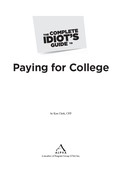Stafford Loans
Federal Stafford loans are the bread and butter of most students’ financial aid package. In fact, they often represent the single largest source of aid received by many students. Unfortunately, they are also the most complex of the federal student loan programs, with a variety of rates and rules that can apply to each borrower. Still, they’re not beyond the average parent or student’s comprehension.
Stafford loans come in both subsidized and unsubsidized flavors. If they’re subsidized, they potentially receive a lower interest rate (depending on the year) and all interest is paid (waived) while the student is still in college. All unsubsidized Stafford loans have an annual interest rate of 6.8 percent and interest does accumulate during the college years.

CHEAT SHEET
Under the Servicemember Civil Relief Act (SCRA), Stafford loans (as well as PLUS and consolidation loans) can have their interest rate limited to 6 percent if the loans were incurred before their active-duty started. Check with your potential lenders for more information if you plan on joining the military at some point.
Stafford Loan Eligibility
As previously mentioned, financial need is not a requirement to qualify for Stafford loans, although it is to qualify for subsidization on those loans. Aside from that, a student must meet the following requirements to receive a Stafford loan.
• Submit a FAFSA form
• Be a U.S. citizen or legal permanent resident
• Be at least half-time in his studies
• Attend a school eligible for federal financial aid
• Not be in default on a previous loan
Stafford Loan Upfront Costs
Stafford loans have historically been subject to two types of upfront costs, which are typically added to the overall balance of a student’s loan. The first type of fee, an origination fee, has historically been as high as 3 percent but was eliminated in mid-2010.
The remaining fee, a default fee, is expected to remain at 1 percent on all disbursed loan amounts. This default fee is used to help the government offset losses from students who do not repay their loans.
Stafford Loan Borrowing Limits
Limits are placed on how much can be borrowed under the Stafford loan program, depending on what year of college (freshman, sophomore, junior, senior, or graduate) they’re being borrowed for. These limits are broken down by both subsidized and total amounts. For example, a student can borrow up to $5,500 for her freshman year, with no more than $3,500 of her loan amount being subsidized. If she does not qualify for any subsidized loans, then she is permitted to borrow unsubsidized Stafford funds, up to that year’s limit ($5,500).
The current Stafford loan limits, subject to change, are shown in the following table.
Stafford Limits for Dependent Students

Further, these limits are increased for students who are independent (no longer financial dependents of their parents) and for students whose parents applied for a PLUS loan and were denied.
Stafford Limits for Independent Students and Students Whose Parents Were Denied PLUS Loans

Stafford loans are also subject to lifetime limits on the total amount that can be borrowed. These limits depend on a student’s status and the level of education she’s pursuing.
Stafford Lifetime Borrowing Limits

..................Content has been hidden....................
You can't read the all page of ebook, please click here login for view all page.
